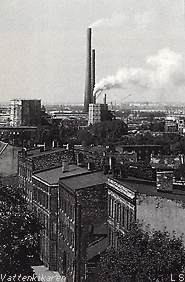The air we breath contains
about 80% nitrogen. Plants usually cannot absorb nitrogen directly
from the atmosphere, but take it up in the form of ions. Therefore
nitrogen in gas form does not directly result in over-fertilization.
The blue-green cyanobacterias are an exception as they are able to
absorb the nitrogen in the atmosphere and therefore contribute to
over -fertilization. This contribution can in the Baltic, comprise
a large proportion of the total delivery. The blue-green bacteria
have the ability to bind nitrogen gas from the atmosphere or decaying
compounds into a nitrate.
Air pollution is another factor because it also supplies
the sea with nutrients. This load is known as atmospheric deposition.
There are mainly two ways for nitrogen compounds to
enter the atmosphere: as ammoniak and as nitrogen oxides from manure
and artificial fertilizer entering
the air and through combustion. Automobile combustion and incineration
in power plants enables the oxygen and nitrogen in the atmosphere
to combine and form compounds of nitrogen oxide. |
These nitrogen oxides are
deposited on the land, in rivers and lakes and directly into the sea,
partly as dry deposits and partly as rain.

Automobile traffic is responsible for about half of the nitrogen oxides
that pollute the atmosphere, the remaining comes from the use of fossil
fuels in, for example, power plants. Those power plants that use coal
are responsible for the greater part.
|



